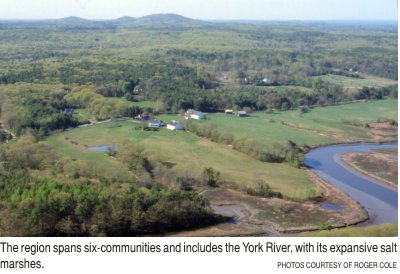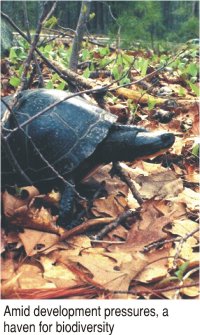
By Lisa Capone
Coalition saving valuable habitat from development
Printer Friendly Page
Nestled within Maine's six southernmost towns, just over an hour's drive from Boston, is a
48,000-acre [1,920-hectare] haven a stone's throw from outlet malls and game arcades that
conservationists say holds the state's greatest terrestrial biodiversity. Three animal and 20
plant species found in this region spanning York, Kittery, South Berwick, Eliot, Wells and Ogunquit
live nowhere else in Maine. And, despite an onslaught of suburban sprawl that pushes the area's growth
rate four times higher than the state average, it still harbors the largest tract of unbroken coastal
forest between Acadia and the Pine Barrens of New Jersey, said Roger Cole, coordinator of the Mt.
Agamenticus to the Sea (Mt. A to the Sea) Conservation Initiative.
“There are 1,000-acre blocks of land that are not fragmented in any way by roads or other
barriers. To have that in an area with the most population and development (pressure) from the
south - it's remarkable that this still remains and that the opportunity still remains to conserve
more of it,” said Doreen MacGillis, executive director of the York Land Trust, one of ten
organizations that comprise the Mt. A to the Sea initiative.
The Mt. A to the Sea project builds on decades of conservation in the six-town region, beginning
when the York and Kittery Water Districts started acquiring property for watershed protection in the
1890s. More recently, the town of York purchased the summit of 691-foot Mt. Agamenticus in 1980,
preventing the construction of 3,000 residential housing units.
The current Mt. A to the Sea campaign, which entered its public phase in June, was launched
in 2002, following a smaller effort by The Nature Conservancy and the York Land Trust that focused
on protecting land surrounding Mt. Agamenticus in 1999 and 2000. In three years, the Mt. A to the
Sea initiative has raised $8.5 million of its $10 million goal from more than 100 donors, landowners
and government agencies. Through conservation easements, land purchases and other measures, Mt. A to
the Sea partners have protected over 1,000 acres. Combined with prior acquisitions, there are now over
11,000 acres of land in conservation throughout the region, said MacGill. She added that reaching
14,000 conserved acres “would be a great achievement” for her group and other members of Mt. A to
the Sea - a coalition that includes Maine Coast Heritage Trust, Rachel Carson National Wildlife
Refuge, Maine Department of Inland Fisheries and Wildlife, The Trust for Public Land, Great Works
Regional Land Trust, Kittery Land Trust, York Rivers Association, Wells National Estuarine Research
Reserve and The Nature Conservancy (TNC).
Located at an ecological crossroads where the northern boreal forest overlaps with southern
hardwoods, the Mt. A to the Sea region provides rich and varied habitats that support “a whole
suite of animals,” including large mammals and songbirds that require large chunks of interior
forests, and amphibians and reptiles that thrive in abundant vernal pools, said TNC Southern
Maine Program Manager Keith Fletcher. The six-town area contains Maine's highest density of
these springtime breeding wetlands, he said, and amorous frogs are so numerous in the mating
season that “you have to yell to someone three feet away to be heard” above their calls.
“This is a unique place,” “Fletcher said. “Inside this forest, embedded in it, are these
smaller ecosystems which are very special.”
“It's a healthy system that's capable of supporting all of the fish species that are common in
this part of the country - and we're doing this in 2005. This part of the country has been settled
for almost 400 years, and this area really isn't screwed up. There are still very good wildlife
values,” points out Rachel Carson National Wildlife Refuge manager Ward Feurt, who maintains that Mt.
A to the Sea coalition members are bent on accomplishing “something that any one of us would be
unable to do by ourselves.”
Just as each of the coalition's ten member groups bring different skills to the table, the
coalition itself helps the region's six towns augment community planning expertise in the face of
unrelenting pressure to develop the area's shorelines, farmlands and forests. A new $15,000 grant
from the Maine State Planning Office (plus a $15,000 match from communities) will enable the Southern
Maine Regional Planning Commission to improve land use planning within each town, and help towns
coordinate planning efforts when proposed developments span two or more municipal borders, said
Commission Executive Director Paul Schumacher.
This work mirrors the initiative's goal of determining “what are the qualities that are there
now that we'd like to see continue into tomorrow,” Cole said. As Mt. A to the Sea coordinator,
he meets with local officials and pores over their master plans, looking for places where local
land use goals overlap with the campaign's Conservation Plan, and then helping communities to
implement those aspects. Maine law requires cities and towns to create comprehensive master
plans every ten years, he said, but small towns often lack the time or personnel to implement
growth management features such as enacting “cluster zoning” ordinances, or working with local
land trusts to protect open space.
Besides protecting ecosystems, the campaign strives to save the traditional character of southern
Maine communities - balancing development with preservation of working landscapes such as farms and
fishing communities, and safeguarding recreational opportunities.
“For years, I've been up there doing mountain biking and, in the winter, cross-country skiing
and snowshoeing, and also horseback riding,” said Barbara McMillan of Portsmouth, New
Hampshire. “The trails just go forever and ever, and you never run into anything in terms of
houses. It's a little oasis in the middle of all this development.”
© 2005 The Gulf of Maine Times
 HOME TO ACADIA National Park, Moosehead Lake and the Allagash Wilderness Waterway, Maine is famous
for backwoods venues and natural beauty. But heading up Interstate 95 en route to these great
northern treasures, many visitors unwittingly miss a place that is arguably the biggest gem of all.
HOME TO ACADIA National Park, Moosehead Lake and the Allagash Wilderness Waterway, Maine is famous
for backwoods venues and natural beauty. But heading up Interstate 95 en route to these great
northern treasures, many visitors unwittingly miss a place that is arguably the biggest gem of all.
 Vernal pools provide food and shelter for several Mt. A to the Sea region species, including
the endangered Blandings turtle. Other rare species native to the region include the spotted turtle,
ringed boghaunter dragonfly, black racer snake and Atlantic white cedar. Thousands of migrating
hawks, peregrine falcons and bald eagles traverse the skies above Mt. Agamenticus each fall, while
the York River harbors 29 species of fish - half of all the species found in the Gulf of Maine.
Vernal pools provide food and shelter for several Mt. A to the Sea region species, including
the endangered Blandings turtle. Other rare species native to the region include the spotted turtle,
ringed boghaunter dragonfly, black racer snake and Atlantic white cedar. Thousands of migrating
hawks, peregrine falcons and bald eagles traverse the skies above Mt. Agamenticus each fall, while
the York River harbors 29 species of fish - half of all the species found in the Gulf of Maine.
Lisa Capone is a freelance writer in
Melrose, Massachusetts.